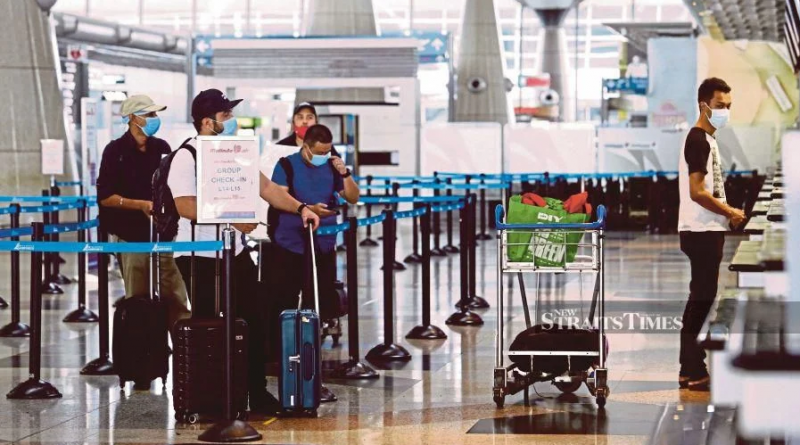Mobile-enabled technology to drive efficiency, minimise airport cost
KUALA LUMPUR: Mobile-enabled common-use technology is expected to be the future assistance for travellers across multiple airports touchpoint.
SITA, an air transport information and technology solutions provider said mobile technology would put passengers and employees back in control and minimise the need for airport infrastructure with its associated costs, while reducing physical contact which may pose a health risk.
SITA Asia-Pacific president Sumesh Patel said the use of biometrics at every relevant touchpoint allows for a frictionless and low-touch passenger journey.
“SITA’s next generation of integrated common-use and digital identity platforms make this possible across the passenger journey. SITA Flex mobile-enabled common-use technology enables passengers to use their own mobile device to check-in, print bag tags or drop a bag without needing to physically touch a kiosk or bag drop,” he told the New Straits Times recently.
Similarly, he said SITA’s WorldTracer Self Service allows passengers to report and monitor the recovery of mishandled bags for themselves on an airline branded mobile app.
“In both cases, passenger experience is enhanced, with minimum time spent queueing in a potentially crowded environment,” he said.
WorldTracer provides airlines and ground handlers with a single, global solution for reporting and tracing lost baggage, which in turn help to reduce costs, simplifying systems and procedures to improve the passenger experience.
“It is perfectly realistic to see innovative industry players deploying these types of technology to differentiate with competitors and more importantly regain passenger confidence in travel,” he said.
Sumesh said investments in technology enable scalable operations and good for long term cost efficiencies and flexibility, given the vulnerability of the aviation industry caused by the ongoing Covid-19 pandemic.
“Whilst it not surprising to find airport operators reducing capital expenditure at this time, SITA has been working with the industry for many years, testing and introducing technology that help not just to improve operational efficiency but cost efficiencies in the long run,” he said.
Sumesh said mobile technology that leverages existing infrastructure can help airlines and airports become more agile and adapt according to changing demand.
Malaysia Airports Holdings Bhd (MAHB) had recently cut over 80 per cent of its planned RM1.8 billion capital expenditure for 2020 to RM320 million as part of its cost-optimisation plan owing to ongoing pandemic.
Efficiency at both airports (touchpoints) and aircraft allow seamless passengers journey, thus facilitating the recovery in air transport amid the new norm post Covid-19.
Sumesh said SITA has a long history of providing advanced passenger processing and airport management solutions to airports in Malaysia, with the latest being Smart Path technology currently on trial at KLIA.
“SITA Smart Path is already fully deployed at many leading airports around the world and demonstrating daily the benefits of contactless passenger flow.
“With check-in completed on mobile devices via SITA Flex and necessary documents printed in-airport in minimal time, biometric-enabled gates get passengers quickly through the airport and onto the aircraft,” he said.
Sumesh said the technology requires no physical documents, touching of shared devices or close interaction with airport or airlines staff.
In the future, he said remote ‘on the move’ iris scanning may be used as an alternate to facial recognition.
“Passengers arriving at the airport without having preregistered over mobile can still enrol in seconds using a biometric enabled kiosk or self-bag drop unit, so they can then enjoy the same frictionless and contactless path to the aircraft,” he said.
Sumesh said SITA currently works with governments, border and other agencies focusing on border management, identity and risk, operations and automation.
“Our solutions provide a complete set of capabilities to enhance every aspect of border operations – through information, intelligence, optimised interactions with travellers, and comprehensive insights,” he said.
He said border solutions will play a critical role in mitigating health risks and re-establishing passenger trust, to help get aviation back up and running.
“As countries ease air travel restrictions, governments are focused on preventing a resurgence of cases. That means opening borders in a controlled manner,” he said.
Sumesh said the air transport industry will need to radically change the way it operates, citing that the recovery and eventual resurgence of the industry will require rebuilding trust among industry players and passengers.
Stepping up operational efficiencies and delivering a safe and enjoyable journey for passengers are important via technology as processes and ways of working, and collaboration among air transport industry players will play an essential role in facilitating the recovery.
He said recovery was underway, although demand will be slow to pick up, affected by deep recession.
In the past few weeks have seen airlines in Asia, Middle East and Europe committed to resuming flights, with others to follow.
This is reflected in resumption in activity across our network and improved baggage volumes, up 55 per cent month-on-month in May where volumes were at a record low.
However, he said there will be the need to comply with evolving health regulations and restore passenger confidence.
“Health is a new requirement for the journey to ensure the safety of travellers and the staff who serve them.
“Airports and airlines need to assimilate new information from governments and health officials. They will also need to create responsive and resilient operations, so they can adapt quickly to events and automate processes permanently, shaping the airport experience of the future,” he said.
Source: NST

